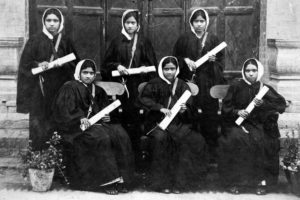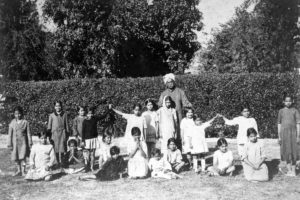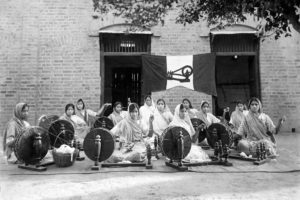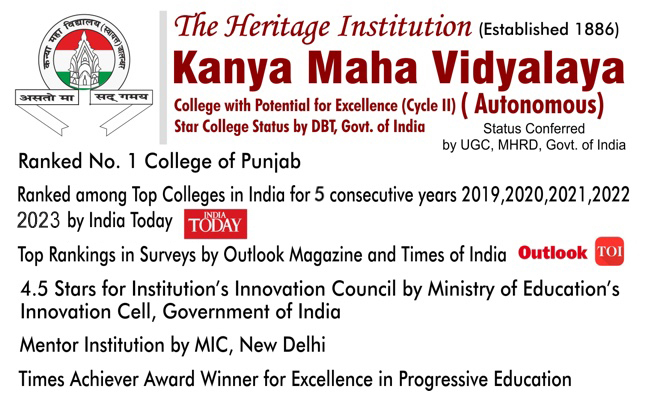Reception Desk : 0181-2296605, 2296606
For Admission related queries : 7009969253,9814406986
Email Id : kmvoffice1886@gmail.com,
kmvjalandhar@yahoo.com
- Only College under GNDU to be bestowed with FIST & CURIE grant by DST- Govt. of India
- Star College by DBT- Govt. of India
- Designated College with Potential for Excellence
- Accredited ‘A’ by UGC-NAAC
- Recognised as a Center of Excellence by RASCI, Government of India
- Best College in Punjab as per the Surveys
- Kaushal Kendra by UGC, MHRD, Govt. of India and first College under GNDU to have been granted Kaushal Kendra
 History of the Institution
History of the Institution
Heritage is our rich legacy, inherited from the past, that we preserve today to bestow to the future generations. The arena of higher education in India possesses a valuable heritage with historic institutions that have stood the test of time for more than a century. With a priceless inheritance of 135 years, Kanya Maha Vidyalaya, Jalandhar, established in 1886, has the proud distinction of being the first educational institution for women in Northern India. It is one of the earliest attempts to give a concrete expression to women education and empowerment. Since its inception, it has shaped the destiny of the nation, the society and women through incredible contribution that was not confined only to the sphere of higher education but encompassed the moral, social and cultural fabric of our nation.
Tranquil and serene, dazzling in pristine white, KMV is the sovereign shrine of women emancipation, as well as a sacred monument of patriotism. Its history is like a sacred pilgrimage into the past. It is not simply a building of plain bricks and stones, but each one of its bricks is bathed in the sweat and blood of innumerable patriots and reformers. The very atmosphere of the Vidyalaya breathes the spirit of sacrifice, devotion and liberal education.
Revolutionary Resurgence (The Beginning)
Founder Father Lala Dev Raj Ji with his little girl students (Jan 25, 1898)
 Founded in 1886 by Lala Dev Raj Ji, the crusader of women education, it is an institution which was started as a result of the renaissance that India witnessed towards the end of the 19th century. A glimpse at its glorious past takes us more than hundred and twenty five years back. Those were the times when degeneration of the society was in full swing. During the British rule, the country was also reeling under the burden of an orthodox, retrogressive society, where women were the targets of infinite atrocities like Sati Pratha, Child Marriages, Purdah System and education, for them, was totally tabooed. The Vedic women, emancipated and educated, fully disappeared under the shroud of pseudo-social values and baseless norms.
Founded in 1886 by Lala Dev Raj Ji, the crusader of women education, it is an institution which was started as a result of the renaissance that India witnessed towards the end of the 19th century. A glimpse at its glorious past takes us more than hundred and twenty five years back. Those were the times when degeneration of the society was in full swing. During the British rule, the country was also reeling under the burden of an orthodox, retrogressive society, where women were the targets of infinite atrocities like Sati Pratha, Child Marriages, Purdah System and education, for them, was totally tabooed. The Vedic women, emancipated and educated, fully disappeared under the shroud of pseudo-social values and baseless norms.
Vidyalaya Managing Committee with Girl Students
 Inspired by the teachings of Swami Dayanand Saraswati, Lala Dev Raj Ji came to the forefront with a missionary zeal and pledged to uplift women from the quagmire of the conservative society and lend dignity, respect and equal status to them. A great visionary and social reformer, Lala Ji verily believed that education of women alone could cure the malaise of the sick society and help in building free India. He took up cudgels on behalf of the hapless, illiterate women relegated mercilessly to the background. He fought tooth and nail to educate women, to make them self reliant and independent. To this end, he established the first institution exclusively for girls in Jalandhar in 1886. As he went from house to house to bring the girls to the Vidyalaya, he was rebuked and driven off by the parents, for whom education of women was almost a blasphemy. But Lalaaji was an indomitable man who refused to give up and started the Vidyalaya with only 3 girl students. To attract more students, he provided absolutely free education.
Inspired by the teachings of Swami Dayanand Saraswati, Lala Dev Raj Ji came to the forefront with a missionary zeal and pledged to uplift women from the quagmire of the conservative society and lend dignity, respect and equal status to them. A great visionary and social reformer, Lala Ji verily believed that education of women alone could cure the malaise of the sick society and help in building free India. He took up cudgels on behalf of the hapless, illiterate women relegated mercilessly to the background. He fought tooth and nail to educate women, to make them self reliant and independent. To this end, he established the first institution exclusively for girls in Jalandhar in 1886. As he went from house to house to bring the girls to the Vidyalaya, he was rebuked and driven off by the parents, for whom education of women was almost a blasphemy. But Lalaaji was an indomitable man who refused to give up and started the Vidyalaya with only 3 girl students. To attract more students, he provided absolutely free education.
This daring step sent waves of shock in our orthodox society and evoked mammoth opposition from male chauvinists and the British Government which propagated western religion and culture. Popular prejudice against women education, lack of women teachers, absence of books were some of the obstacles that had to be faced. Undaunted by the setbacks and the scornful attitude of conformist society, Lala Ji persisted with his efforts and continued to nurture the seedling with selfless devotion which was christened ‘Arya Kanya Pathshala’ and adopted the name ‘Kanya Maha Vidyalaya’ in 1896.
Lala Devraj Ji initiated a self sufficient system of education by evolving his own curricula of studies, writing books, raising funds, training teachers and enlisting the services of a band of selfless assistants in his work. He boldly refused financial assistance offered by the British Government in India after the visit of some English officials to the college. A twelve year course of studies with Hindi, Sanskrit and Religion Studies as primary subjects was evolved. Instead of relying on available material, books to be used for teaching like Pathshala Ki Kanya, Shabdavali, Katha Vidhi, Semeeranis, Pathavali, Balodyan Sangeet were written in house and published by the Vidyalaya.
Panchal Pandita, Published from KMV, the First Magazine for Women in Punjab
 The literature published by the Vidyalaya took the message of women education into many homes and helped to mould many young minds and lives. The Panchal Pandita, a periodical published from KMV, was launched in November 1897 by the efforts of Lala Devraj Ji. It was the first magazine for women in Punjab. Under his guidance it reached out to the educated women of north India with the aim of ameliorating their position. Till April 1901, the magazine consisted of 16 pages in April 1901 onwards it was issued in Hindi language only. Savitri Devi, a widowed student who later became the Principal of the KMV in 1913, became its sub-editor from January 1903 onwards.
The literature published by the Vidyalaya took the message of women education into many homes and helped to mould many young minds and lives. The Panchal Pandita, a periodical published from KMV, was launched in November 1897 by the efforts of Lala Devraj Ji. It was the first magazine for women in Punjab. Under his guidance it reached out to the educated women of north India with the aim of ameliorating their position. Till April 1901, the magazine consisted of 16 pages in April 1901 onwards it was issued in Hindi language only. Savitri Devi, a widowed student who later became the Principal of the KMV in 1913, became its sub-editor from January 1903 onwards.
1924 Batch of Graduates of the Vidyalaya
The Vidyalaya was not affiliated to any university till 1944 and awarded its own certificates titled Sabhya, Sikshita, Deekshita, Up-Snatika and Snatika. The Vidyalaya successfully produced the first generation of right-thinking, noble-minded educated women enthused with the essence of our rich vibrant culture heritage and ethos and infused with the spirit of patriotism and service to the nation.
Initial Building of Kanya Ashram (Boarding House) Inaugurated in 1910
To support education for women from far and wide, hostel facility was also provided to the students with effect from 1895. The building of Kanya Ashram (Boarding House) was eventually inaugurated in 1910 by the Maharaja of Kapurthala before which it was housed in smaller accommodations. Kanya Ashram attracted girls from as far as Bombay, Gwalior State, Gorakhpur, North West Frontier Province, Balochistan, Bihar, Bengal and even Fiji and Africa. Orphans and widows were also supported and educated by the Vidyalaya. Presently, the boarding house is known as ‘Diwan Badridas Chaatravaas’. It still is a home away from home to girl students from all over the country as well as abroad. Right in the middle of the courtyard of this historic building stands the ancient banyan tree which is as old as the Vidyalaya and has provided its cooling shade of knowledge, learning, peace and love to numerous scholars who have passed the pulsating portals of this institution.
Daring Dates
- September 1886: Birth under the name ‘Arya Kanya Pathshala’
- 1895: Start of ‘Kanya Ashram’ (Boarding House)
- 1896: Adopts the name ‘Kanya Maha Vidyalaya’
- 1910: Inauguration of present building of Kanya Ashram (Boarding House)
- 1944: Affiliated to Panjab University
- September 1986: Centenary celebration
- Clashing for a Cause (Contribution in Indian Freedom Struggle)
The college has the proud distinction of having been an active participant rather than a mute spectator in the Indian Freedom Struggle. The Vidyalaya was dedicated to the fiery spirit of nationalism. The degrees conferred on the students were not only certificates of education, but also of patriotic zeal and selfless sacrifice to the cause of freedom.
The students of this august institution helped the famous martyr Bhagat Singh escape the chasing British. The name of Sushila Devi, a student of the Vidyalaya, who fought bravely against the British rule in close association with freedom fighters like S. Bhagat Singh, Chandrashekhar Azad, Bhagwati Charan etc. and was addressed as ‘Didi’ by them, is etched in the pages of history forever. When the great national leader, Lala Lajpat Rai, was in jail in Dharamsala, the students of this institution sent him Rakhi and clothes made of khadi spun by them. They led several processions against the British atrocities. Under the proficient stewardship Students spinning ‘Charkha’ and weaving the National Flag- The Emblem of ‘Swadeshi Movement’
Batch of our Students who participated in the significant 1929 session of the Congress declaring ‘Puran Swaraj’
Responding to the Gandhian call for freedom struggle, the students of the Vidyalaya came out in the open and participated wholeheartedly in social and national movements. A batch of students participated in the Annual Convention of Indian National Congress in 1919 at Jallianwala Bagh, Amritsar and recited Vande Mataram. The teachings of Gandhiji were fully incorporated by the Vidyalaya students. Following the Mahatma’s footsteps, the girls heartily spun the Charkha, the symbol of the Swadeshi Movement. Khadi was worn by all and sundry associated with the Vidyalaya. The students also took part in the significant 1929 session of the Congress where the resolution of Purna Swaraj was adopted. The group of students that presented the Tricolour to Pt. Nehru on this historic occasion belonged to Kanya Maha Vidyalaya.
Our Students Hoisting the National Flag and Singing ‘Vande Matram’ during Independence Struggle
In spite of strong British opposition, the National Flag was hoisted regularly in the Vidyalaya premises on a tall staff that was visible for miles around and the students chanted ‘Vande Matram’ with nationalistic fervour. In keeping with the same nationalistic spirit, Khadi uniform is still worn on Mondays and the national flag is hoisted on the same tall post in the grounds on which it was unfurled before independence a hundred years ago.
By virtue of the glorious role played by it in India’s struggle for Independence and the splendid service it rendered to the re-awakening and education of Indian women, the Vidyalaya gradually assumed the character of a national institution. It became a guiding star for women institutions across the country. On Nov 13, 1920 when Gandhi Ji inaugurated the Gujarat Peeth in Ahmedabad, he said, “It is formed after the model of Kanya Maha Vidyalaya”.
Legacy of Learning (Moral, Cultural & Intellectual Heritage)
Committed to preserving our rich cultural legacy and traditional values, the college harmoniously blends tradition and modernity to create an ambience conducive to the holistic development of an individual’s potential. The rich tradition of patriotic ideals and commitment towards high moral values make KMV the prototype of value education. Many healthy practices that were born at the time of the Vidyalaya’s inception have continued till today. These include Morning Assembly on Monday, ‘Saraswati Puja’, ‘Amar Jyoti’ and ‘Van Mahotsav’. ‘Saraswati Puja’ and ‘Amar Jyoti’ are the ceremonial welcome and farewell functions for students that are organized even today.
Saraswati Puja is a novel way of welcoming the new entrants to the college with the ‘Vidyalaya Swagat Geet’ who respond their gratitude through the ‘Dhanyawad Geet’. Obeisance is also paid to Goddess Saraswati, the Goddess of Learning and motherland India and their blessings are sought for a successful year ahead.
‘Amar Jyoti’ being Celebrated on the Campus
Amar Jyoti, the most pious ceremony of KMV marks the culmination of the academic session. Outgoing students convey their gratitude to the Vidyalaya for nurturing them like a mother through the song ‘Jai Jai Janani’. The ‘Amar Jyoti’ or the flame of knowledge which they had received from their seniors is turned over to the junior students. This passing on of the Jyoti is symbolic of the handing over of the Vidyalaya’s traditions and culture from one generation to another where each generation promises to protect it, safeguard it and keep it alive. While seeking blessings for a bright future, the outgoing students in their turn pray for the prosperity of their alma mater. These unique ceremonies, which are as old as the Vidyalaya itself, are exclusive to KMV and are unlike any other college where the students are ragged instead of being blessed.
Students Planting Trees During ‘Van Mahostav’
The Vidyalaya’s visionary consciousness has not been confined to women alone. Since it bloomed amidst vibrant nature, far away from the madding crowd, the Vidyalaya formed a divine connection with nature which was rejoiced in the form of ‘Van Mahotsav’. The students planted trees while singing ‘Van Mahotsav Song’ during the celebration. Right from the beginning, the Vidyalaya’s serene grounds have remained home to numerous peacocks, which have prospered in the healthy surroundings of the Vidyalaya and cohabit peacefully with the students. ‘Mor Bagh’, the special garden, was developed specifically to provide natural environment to these peacocks, where they could live in harmony with nature. At present, the Mor Bagh houses about 100 peacocks.
Pioneering Pulses (Landmark Achievements)
Through 135 eventful years of its existence, KMV has striven ceaselessly to expand landscapes of learning. Keeping pace with the times, the college has always offered courses and activities that help develop individual skills, knowledge and creativity for empowering women and permitting a wide choice of career opportunities. It is a college with many firsts to its credit
- North India’s oldest women institution, celebrating 135 years of glorious service to the cause of women education
- Panchal Pandita was the first magazine published in Hindi in the Punjab and Savitri Devi was the first woman editor of this region
- First girl student to clear Shastri Examination of Punjab University in 1914 was a student of the Vidyalaya named Satyavati
- First college in the region to introduce NCC for its students
- First girls’ college in the region to begin Science (B.Sc.), Commerce (B.Com. & BBA) and Computer (BCA) education for its students
- First and only women institution under Guru Nanak Dev University to offer M.Sc. (Physics)
- First and only college in North India to have M.Sc. (Information & Network Security) – An innovative programme fully funded by UGC
- First and only women college in Jalandhar to offer the prestigious B.A. (Hons.)English
- First college in Jalandhar to run PG Diploma in Environment Management
- First and only college under GNDU to offer a combination of two vocational subjects-Food Science & Quality Control and Microbiology in B.Sc. (Medical)
- First and only college under GNDU to offer Electronics as an elective subject in B.Sc. (Non-Medical)
- First and only women college in the region to set up ‘Gandhian Studies Centre’, ‘Women Studies Centre’ and ‘Women Empowerment Cell’ in keeping with its commitment to women and society
- First and only college to offer innovative programmes like Foundation Programme, Personality Development, Spoken English and Foreign Languages to its students
- First college to undertake E-content Development Programme sponsored by Consortium for Educational Communication, UGC
- Recipient of Overall Sports Trophy of the University for 13 consecutive years
- Conferred the status of ‘College with Potential for Excellence’ by UGC
- Selected as Model College for the visit of NIEPA team (National Institute of Educational Planning & Administration) for the Orientation Programme of Principals from various states of India.
- Granted the most coveted membership of US College Board, New York, USA
- The only college in the region to have organised 9 international conferences which garnered participation of experts and scholars from Ivy League Universities
Worthy Visits & Views
Due to its historic significance and patriotic credentials, almost all national leaders — from Lala Lajpat Rai, Pt. Madan Mohan Malviya, Smt. Sarojini Naidu, Dr. Rajendra Prasad, Dr. Radha Krishnan, Dr. Fakrudin Ali Ahmed, Giani Zail Singh, Dr. A.P.J Abdul Kala m, Pt. Jawahar Lal Nehru, Sh. Morarji Desai, Smt. Indira Gandhi, Smt. Sucheta Kriplani, Sh. I.K. Gujral to Sh. Atal Bihari Vajpayee have visited this august institution from time to time. This list includes five Presidents and five Prime Ministers who visited the college while in office. Father of the Nation, Mahatma Gandhi was slated to visit the Vidyalaya in 1920 but the visit was called off at the last moment due to his involvement in leading the Non-Cooperation Movement.
- Pt. Jawahar Lal Nehru the first Prime Minister of India being welcomed in the college campus
- Dr. Radha Krishnan President of India during his visit to the college
Words of Notable Visitors to the Vidyalaya
- W. Bell Esquire (Director of Public Instruction, Punjab – Nov. 27, 1905)
“I paid a short visit to this school on the 20th November, 1905. There is no girls’ school in the province for which I have greater liking and admiration..It is a pleasure to visit this institution where the pupils all look so clean, bright and well cared for.” - C. R. Ewing (Principal, FC College Lahore & VC, University of Punjab)
” I had very great pleasure in visiting the Kanya Maha Vidyalaya… I brought away with me a very definite impression most favourable to the work being done by the school. Its influence in the Punjab has already been very great..” - H. H. The Maharaja of Gaekwar (October 11, 1911)
“The institution is doing really very good service to the society and if India will have many institutions like this, the advancement of the women class and consequently of India in general will not be far off.” - Sarojini Naidu (President, National Congress – November 2, 1925)
“Today, it was a source of especial pleasure for me to spend an hour in this delightful garden of girls who are growing and expanding their brains and souls in an atmosphere of harmony and sweetness which will prove of incalculable in their later and more responsible life. National education in its truest sense is being imparted in this institution.” - Dr. Rajendra Prasad (First President of Independent India)
“Our country is proud of this institution.” - Pt. Jawahar Lal Nehru (First President of Independent India)
“Punjab is fortunate to have an institution like Kanya Maha Vidyalaya.” - Lala Lajpat Rai (Novenber 5, 1924 to the students of KMV)
“May God Bless you with the purity of Sita, the beauty of Padmini and the courage of Laxmi Bai. From the bottom of my heart I wish every success to Kanya Maha Vidyalaya in all the phases of its activities.” - W. Jones, an American writer in the book Arya Dharam
“This institution is the pioneer in women education and women liberation in India.” - The Tribune of February 1, 1907
“There is no institution like Kanya Maha Vidyalaya in the whole of India”.
The Vidyalaya has the distinguished privilege of being mentioned twice in the esteemed column ‘This Day 100 Years Ago’ of the respected national daily The Tribune. History impressed by the glorious history of this national institute which has played a pivotal role in national building and women empowerment, the former President of India, Dr. A.P.J Abdul Kalam, visited this college to address and interact with the future women leaders of India. While lauding the contribution of KMV, Dr. Kalam reaffirmed his faith and hope in this institution by administering the oath: “We pledge to uproot corruption. We pledge to be noble citizens. We pledge to create a strong and peaceful nation.” The hallowed corridors of the college reverberated with one voice of the President and KMV family. It was in this fashion that we redeemed the pledge of our founding fathers who, imbued Dr. A P J Abdul Kalam interacting with KMV students during his visit, while in office as President of India with patriotic zeal and futuristic vision and resolved to convert our nation into a formidable powerhouse.
Acclaimed Alumnae
KMV is enriched by five generations of educated alumnae who are spread worldwide and have been rendering distinguished service in high profile positions of authority as IAS officers, doctors, engineers, musicians, solicitors, charteres accountants, media professionals, researchers, technocrats and educationists. Smt. Satyawati, the mother of former Vice President of India, Late Sh. Krishna Kant, was among the first graduates of this college. On the illustrious list of alumnae are renowned names like Acharya Lajjawati, Sushila Didi (noted freedom fighter), Ambika Soni (Member of Parliament & Former Union Minister of Information and Broadcasting), Surinder Kaur Badal (Late wife of S. Parkash Singh Badal, Chief Minister of Punjab), Padma Bhushan Surendra Saini, Manorama Diwan, Tara Meenakshi (prominent social worker), Neelima Whig, Gauri Sud and many more.
Reverent Research
Due to its everlasting imprint on the sands of time, the Vidyalaya has been a befitting subject of significant research in the sphere of women emancipation and empowerment. Numerous articles about the path breaking role of the Vidyalaya in uplifting the status of women have been published in various books and articles. Notable among these are
- Legacy of Women’s Uplift in India: Contemporary Women Leaders in the Arya Samaj by J. E. Llewellyn
- Serving the Nation: Cultures of Service, Association, and Citizenship by Carey Anthony Watt
- Women in Colonial India: Essays on Survival, Work and the State edited by Jayasankar Krishnamurty
- Visualizing Indian Women, 1875-1947 by Malavika Karlekar
- Women and the Wind of Change by Vinita Kaul
- Women and Social Reform in Modern India: A Reader edited by Sumit Tanika Sarkar
- “Arya Samaj & Women’s Education: Kanya Maha Vidyalaya, Jalandhar” by Madhu Kishwar in Economic and Political Weekly – Volume 21, Issue 2.








